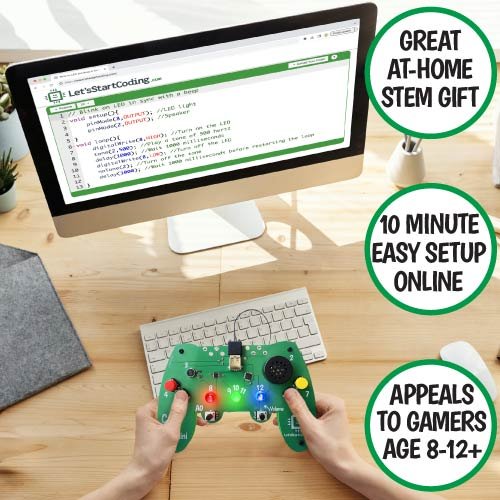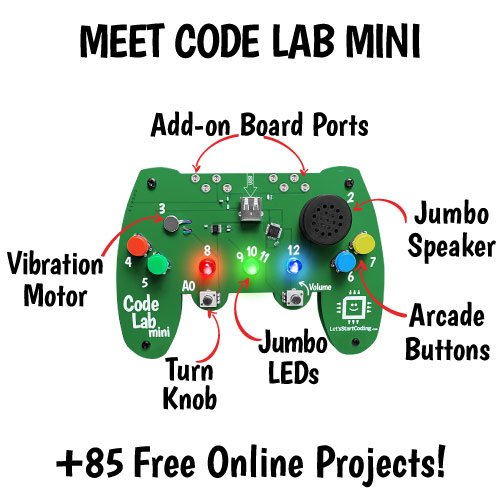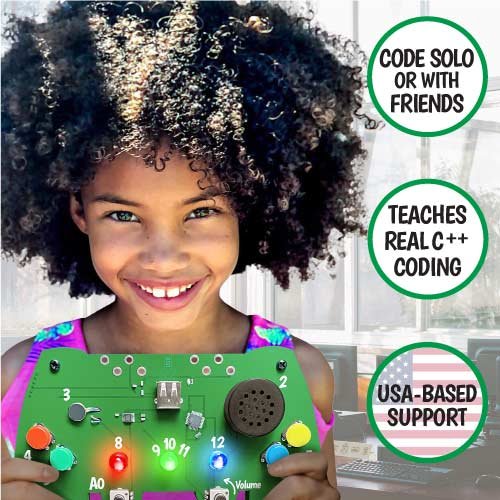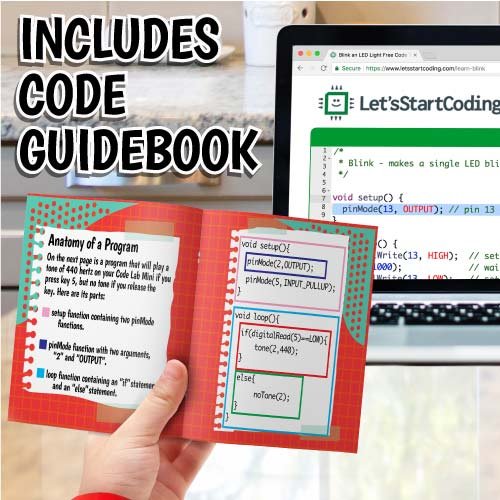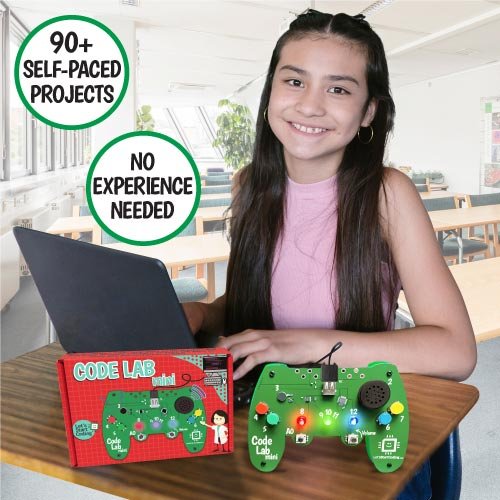SHOP > Code Lab Mini Details
Code Lab Mini looks like a game controller, but your young coder is the one in control! Code Lab Mini is a circuit board with built-in microcontroller brain, jumbo LED lights, arcade-style buttons, a vibration motor, jumbo speaker, and turn knob. Kids will get introduced to real typed coding by creating bright light displays, custom songs, button-activated motor buzzes, and more.
With over 80 code projects included (plus more available with the add-ons), Code Lab Mini is a great way for kids 8-12 to get excited about coding. While it looks like a toy, Code Lab Mini is actually packed with learning value that kids get from making their own coded circuits!
No assembly is required for the basic Code Lab Mini, and assembling add-on kits takes under 10 minutes. Right out of the box, kids will be able to plug Code Lab Mini in and start to beep, blink, and buzz the components before launching into changing how the board works with real code. USB cable and reference guidebook included, plus free web-based coding software and walkthrough videos, challenges, and tutorials.
Code Lab Mini is a great choice whether you’re looking to get your kids to spend more valuable screentime than just gaming, or you want to kickstart their game-developer career with some engaging code.
- Code Lab Mini circuit board with ATMEGA328P microchip
- Retractable USB cable
- Instruction and code reference book
When you buy a Let's Start Coding kit, you get much more than a box of 'stuff'. Free with every kit is access to our downloadable coding software for Windows, Mac, or Chromebook computers, plus tons of learning content. For Code Lab, this includes:
- 80+ sequenced project pages that cover the fundamentals of all coding languages
- Thousands of lines of example code that can be modified or tinkered with
- Hours of walkthrough videos that accompany the projects,explaining how the code works so kids can make changes of their own
- Code 'challenges' and 'bug hunts' that encourage kids to interact and engage with the code, strenghtening their learning
Using the free online software in a Google Chrome or Microsoft Edge browser on Windows, Mac, or Chromebook desktops or laptops (no tablets or phones), coders can complete over 100 projects through 9 "chapters" that help organize and sequence the kits so kids don't get lost or overwhelmed. Click each chapter below to see the projects included in it.
Chapter Zero: Setup Code Lab Mini
0.0 Build Code Lab Mini & First Code Upload
0.1 Code Editor Tour
0.2 Project Page Tour
Chapter One: Single Functions
1.0 Blink an LED
Bug Hunt: 1.0 Blink
1.1 Single Beep
1.2 Buzz a motor
1.3 Two LEDs Synced
Bug Hunt: 1.3 Two Synced LEDs
1.4 Play 3 Tones
Bug Hunt: 1.4 Play 3 Tones
1.5 Serial Print Each Loop
1.6 Alternating Blinks
Bug Hunt: 1.6 Alternating Blinks
1.8 AnalogWrite motor
1.9 RGB LED Color Mixer
Chapter Two: Combined Functions
2.0 Blink and Beep
Bug Hunt: 2.0 Blink and Beep
2.1 Buzz and Blink
2.2 Buzz and Beep
2.3 Buzz and Beep and Blink
2.4 Siren
Bug Hunt: Siren
2.5 Sound and Light Show
Chapter Three: Conditionals
3.0 Press For Light
3.1 Press For Sound
3.2 Hold For Light
3.3 Hold To Buzz Motor
3.4 One Note Piano
Bug Hunt: 3.4 One Note Piano
3.5 Serial Print Button Press
3.6 RGB Color Mixer
Bug Hunt: 3.6 RGB Color Mixer
3.7 Twist For Light
3.8 Twist For Motor Buzz
3.9 Four Note Piano
Bug Hunt: 3.9 Four Note Piano
3.10 Four Note Piano with LED
Chapter Four: Functions Inside Functions
4.0 Random Blink Delays
4.1 Random Motor Buzz Delays
4.2 Random Beep Delays
4.3 Serial Print Random Values
4.4 Random Tones
4.5 Random Motor Strength
4.6 Random Tones & Random Delays
4.7 Random LED Colors
4.8 Random Beep and Blink Delays
4.9 Attention Grabber (Random Everything)
4.10 Turn Knob Tone
4.11 Serial Print Turn Knob Values
4.12 digitalWrite a digitalRead
4.13 Turn Knob LED Brightness
4.14 Turn Knob Motor Strength
4.15 Show Button and LED Status on Serial Monitor
Chapter Five: Constant Variables
5.0 Constant Blink Variable
5.1 Constant Beep Variable
5.2 Serial Print Constant Variable
5.3 Four Note Piano Variables
5.4 Variable Key Piano
Chapter Six: Toggle Variables
6.0 LED Flashlight
6.1 Serial Monitor Toggle Variable
6.2 Random Tone 'Latch'
6.3 Motor 'Latch'
6.4 Toggle Between Two LEDs
6.5 Toggle Between Three LEDs
Chapter Seven: Linear Variables
7.0 Serial Print a Counter
7.1 Rising Tone Variable
7.2 Rising Brightness Variable
7.3 Rising Motor Jitter
7.4 Blink Delay Divided By 2
7.5 Button Raises Tone
7.6 Buttons Raise and Lower Tone
7.7 Buttons Raise and Lower LED Brightness
7.8 Buttons Raise and Lower Motor Strength
7.9 Button Doubles Speaker Tone
7.10 Turn Knob LED Brightness
7.11 Turn Knob Motor Strength
7.12 Color Tuner
7.13 Turn Knob Blink Delay
7.14 Turn Knob Beep Delay
Chapter Nine: For Loops
9.0 Fade Up LED
9.1 Fade Up Tone
9.2 Fade Up Motor Strength
9.3 Fade Up Tone and Print Variable Value
9.4 Fade Up Motor and Print Variable Value
9.5 Motor Strength Fades Up and Down
9.6 Fade LED Up and Down
9.7 Fade Tone Up and Down
9.8 Blink Row of LEDs
9.9 LEDs 'Up and Back'
- Coding in the C++ (see-plus-plus) coding language
- Microcontroller is ATMEGA 328P, like the Arduino Uno board
- Software is compatible with Windows 7, 8, 10 and Mac OSX 10.9 and above, plus Chromebooks.
- Software requires internet connection to code.
- No batteries are required - the board is powered by the USB port.


